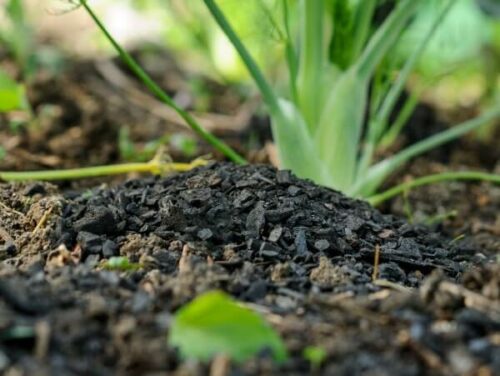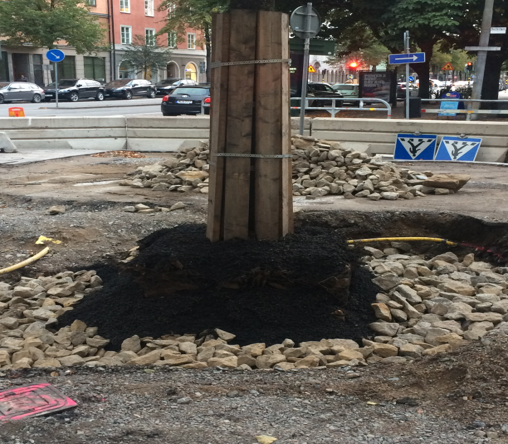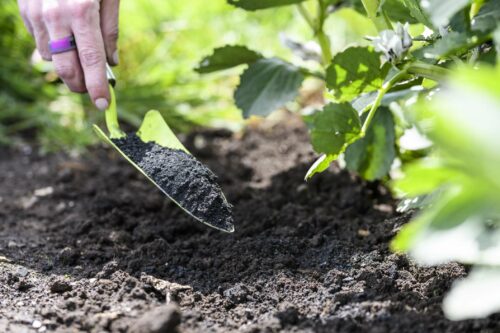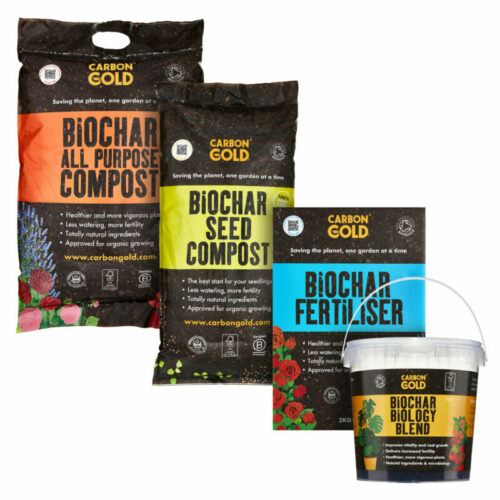Biochar’s effect on water conservation

OVERVIEW
Because of the way biochar is made, it’s extremely porous and its sponge-like structure lends itself well to water conservation. Whether they work in tree care, commercial horticulture, or sports turf, all of our customers know and benefit from our enriched biochar’s ability to improve the water holding capacity of soil and substrates. But there’s a huge amount of data out there by independent researchers and scientists, this is just a few examples. This makes it a perfect natural aid to water conservation.
HIGHLIGHTS
- Biochar will increase water-holding capacity and cation exchange capacity of sandy soils; water-holding capacity in sandy soils can be increased by up to 22% and soil compaction ameliorated by 15%
- Significant yield increases have been found where medium and coarse-textured soils have had biochar added, likely to be due to improved water holding capacity
- Studying 5 soils from a desert area of China, additions of biochar from mixed tree prunings were found to increase soil water content and reduce evaporation compared to untreated soils. Evaporative losses were reduced by larger particle size biochar (1-2 mm) compared to fine biochar (<0.25 mm), this was due to the higher surface area and water absorbing capacity of the larger particles.
- Biochar derived from maize cobs (slow pyrolysis at 350oC ) added at relatively low rates (0, 2 and 6 ton/ha) to basins growing maize and soya beans was able to increase Available Water Capacity and soil aggregate stability by 3% per 1% added biochar (sandy loam soil in central Zambia), and reduce bulk density of the soil by 3-5% per 1% added biochar. Authors commented that this was very important for “droughty” soils in the region where rainfall can be erratic.
- As part of the above study plant available water (AWC in the above paper) and pore volume significantly increased with biochar additions and bulk density decreased. Yield increased slightly for maize but was not significant with additions of biochar.
- Using a highly weathered silty clay soil in South Taiwan, an incubation experiment lasting 105 days with biochar from white lead trees mixed in at 0,2.5 and 5%, bulk density was reduced from 1.4% to 1.1%, porosity increased from 41% to 52%, saturated hydraulic conductivity increased from 17% to 33%, the mean weight diameter of particles increased from 46% to 50%. Microbial biomass increased by 50% during the trial, the authors ascribe production of gums and mucilage helping to bind together soil particles. In a simulated rainfall runoff trial soil erosion rate was halved with 2.5% biochar and reduced by nearly 3 times for the 5% rate. The authors recommend a 5% inclusion rate of biochar to amend soil properties and reduce soil erosion
PAPER REVIEWS
Subedi, R. et al. (2017) summarised the many benefits of adding biochar to soils, sandy soils have greater water holding capacity, silt and clay soils have increased soil aeration.
Jeffery, S. et al (2011) reviewed a very large number of field experiments where biochar had been applied and yields recorded. Looking at soil textural class and biochar addition, significant crop yield increases were seen with medium (loam) and coarse(sandy) textured soils but not fine textured e.g. (clays, silts). However, there wasn’t a negative effect of biochar on crop yields in the fine texture classes. Jeffery reported a small (10%) but significant yield increase in crops with biochar additions overall but cautioned that it is likely that the main benefits of biochar are coming from the liming effects of acidic soils and water-holding effects on coarse and medium textured soils.
Omondi et al. (2016) carried out a meta-analysis of studies of biochar and benefits to soil physical properties (38 papers, 128 datasets). Soil bulk density was reduced by an average of 7.6% across all rates and sources of biochar (wood, manure, crop residues), most of the results were for coarse-textured soils, but for fine-textured soils, a reduction of 9% was found. Reduced bulk density would enable greater root penetration and movement of water.
Available water capacity (the water held in the soil for plant growth between field capacity and permanent wilting point) was increased by 15% on average, up to 25% with very high additions of biochar, Finally, saturated hydraulic conductivity was increased by 25% on average – increased water movement in soils.
Wang et al. (2018) studied five desert soils in China from the Loess Plateau with different additions of biochar in soil columns under controlled conditions. Biochar was derived from mixed wood, had a pH of 9.0 and contained 83% carbon. Application rates were 0, 10,50,100 and 250 g biochar/kg soil (0,26,130,260 and 390 te/ha equivalent). Three size ranges of biochar were added: 1-2 mm, 0.25-1.0 mm and <0.25 mm grade. The soil was mixed with biochar and packed into columns in tubes 10 cm deep x 10 cm diameter. Soils were saturated from the bottom, the top of the column sealed with plastic film to stop evaporation. The trial lasted 33 days.
Biochar overall increased soil water content, average across the 5 soils and 3 particle size ranges were 33.5% water content for control (no biochar) and 35.6% water content for biochar. With increasing rates of biochar water content increased, generally also as particle size range decreased the water content also increased. The five soils ranged from loamy clay, sandy clay loam, sandy loam and sand Example below is for just one soil, aeolian sand, at the two extremes of biochar addition in the trial, however, similar results were shown for all soils:
% soil water content for aeolian sand sample averaged across particle size ranges for rates of biochar added and lowest and highest rates of biochar in columns 4-7
| Treatment | Water content | Treatment – 10 g/kg soil | Water content | Treatment 150 g/kg soil | Water content |
| Nil biochar control | 19.3 % | Nil biochar control | 19.3 % | Nil biochar control | 19.3 % |
| 10 g/kg biochar | 19.5 % | 1-2 mm | 19.5 % | 1-2 mm | 23.4 % |
| 50 g/kg biochar | 21.3 % | 0.25 – 1 mm | 20.0 % | 0.25 – 1 mm | 24.9 % |
| 100 g/kg biochar | 22.0 % | < 0.25 % | 19.6 % | < 0.25 % | 27.0 % |
| 150 g/kg biochar | 23.3 % |
Cumulative evaporation (CE) losses were measured and reduced by all biochar additions and rates, the larger particle sizes (1-2 mm) were more effective than the smaller particle sizes (below 0.25 mm) at reducing CE, due to larger surface area and higher moisture absorbing capacity and water holding capacity of larger particles slowing down evaporation. Grinding down biochar destroys the pore structure which reduces the water absorption capacity and hydraulic conductivity. Explanation regarding the figures in the table above and observations of CE is that initial evaporation is slowed down by small particle sizes blocking up pores, however in the second stage of evaporation losses are greater from the fine biochar particles increasing the diffusion rate of water vapour.
Obia et al. (2016) produced one of the very few studies in the field rather than in the laboratory, looking at Available Water Capacity (AWC) of soils (AWC = Field Capacity (FC) minus Permanent Wilting Point (PWP)). Work was carried out in central Zambia, the soil was sandy loam (experiment A in the paper) pH 5.8, low in CEC and organic matter. Biochar sources were from maize cobs (pH 9.7, 81% organic carbon) and rice husks (pH 8.3 39-43% organic carbon), pyrolysis temperature around 350oC and retention time of 1-2 days i.e. slow pyrolysis biochar.
Biochar was added to planting basins and mixed in with fertiliser where maize was grown, rates of addition were equivalent to 0,2 and 6 tonnes/ha (0, 0.8 and 2.5% biochar added to soil w/w); standard fertilizer was added each year of the 2-year trial as 78 kg/ha N, 28 P2O5, 14 K2O and 8 SO3. Biochar increased aggregate stability and AWC by around 3% per 1% biochar added and decreased bulk density by 3-5% per 1% biochar added. There was also an increase in Field Capacity, but no change in PWP i.e. soils were able to hold more water due to increases in pores from the added biochar. Increase of AWC is very important in this region of “droughty” soils with erratic rainfall patterns.
Martinsen (2014) in the same study above detailed yields and Plant Available Water (AWC in a previous paper by Obia et al.). There was a small but non-significant yield increase from increasing biochar rates for both maize and groundnuts grown in this trial. However, there were significant increases in PAW and decreases in soil bulk density from the biochar additions:
Mkushi site, Central Zambia – Biochar additions to the basins (not surrounding soil)
| Biochar rate | 0 | 2.5 % | 5.0 % | 10.0 % |
| PAW % vol | 18.2 | 20.2 | 22.3 | 22.7 |
| Soil BD g/cm3 | 1.31 | 1.23 | 1.18 | 1.08 |
| Pore volume % | 49.8 | 53.3 | 54.3 | 57.7 |
PAW = Plant Available Water between FC and PWP
BD – Soil bulk density
Pore volume also increased due to the added biochar, all these properties have a beneficial effect on soil moisture retention. Lack of yield response was ascribed to the plants being grown in basins rather than rows in fields, yields were higher than average for the area as well.
In Taiwan, Jien and Wang (2013) studied a highly weathered soil in an incubation trial in large pots, adding either 0, 2.5 or 5% biochar to the pots. The biochar was sourced from white lead trees and pyrolyzed at 700oC. The biochar was very alkaline (pH 9.9) and had a high total carbon content (78.3% TOC). The soil was a silty clay, acidic (pH 4.0), with low CEC and low soil organic matter (2%) .15 kg of soil for each treatment was saturated with water and the pots were sealed and weighed every 5 days for 105 days. As well as chemical measurements (not in the table) physical measurements were made which can be seen in the table below at the end of the trial. A simulated runoff trial using rainfall at 80 mm/hr. and a 10% slope was part of the work to look at benefits of biochar in reducing soil runoff.
Soil physical parameters after 105 days incubation of soils with biochar at two rates
| Biochar rate | BD | Porosity | MBC | Ksat | MWD | SER |
| 0 | 1.42 | 41.0 | 835 | 16.7 | 45.6 | 1458 |
| 2.5% | 1.15 | 51.0 | 977 | 30.0 | 48.2 | 730 |
| 5.0 % | 1.08 | 52.0 | 1262 | 33.1 | 50.0 | 532 |
BD = bulk density te/m3
Porosity = soil porosity by %
Ksat = saturated hydraulic conductivity in cm/hour
MBC = microbial biomass carbon mg/kg
MWD = mean weight diameter of aggregates in cm
SER = soil erosion rate (runoff trial) g/m2/hour
Biochar has considerably reduced soil bulk density in this trial by around 30% at the highest rate of biochar, allowing more air spaces, porosity has increased as has saturated hydraulic conductivity, allowing water to move in the soil profile. Aggregates are enlarged with biochar by around 10%, allowing more water to be stored. The authors ascribe some of these benefits to enhanced microbial biomass, the microbes producing gums and mucilage which helps to bind soil particles. The 5% rate biochar increased microbial biomass by 50% by the end of the trial.
In the runoff trial using a high rate of simulated rainfall of 80 mm/hour the 2.5% biochar rate reduced soil runoff by 100%, this was even higher with the 5% rate (2.7 times less soil runoff), soil particles being bound together by the biochar.
REFERENCES
Subedi, R. et al. 2017. Italian Journal of Agronomy 12 161-173 “Crop response to soils amended with biochar: expected benefits and unintended risks”
Jeffery, S. et al. 2011. Agriculture, Ecosystems and Environment 144 175-187 “A quantitative review of the effects of biochar application to soils on crop productivity using meta-analysis”
Omondi, M et al. 2016. Geoderma 274 28-34 “Quantification of biochar effects on soil hydrological properties using meta-analysis of literature data”
Wang, T. et al. 2018. Catena 162 29-39 “Effects of biochar addition on evaporation in the five typical Loess Plateau soils”
Obia, A. et al. 2016. Soil and Tillage Research 155 35-44. “In situ effects of biochar on aggregation, water retention and porosity in light-textured tropical soils”
Martinsen, V et al. 2014 J. Plant Nutr. Soil Sci 177 681-.695 “Farmer-led maize biochar trials: Effect on crop yield and soil nutrients under conservation farming”
Jien, S-H and Wang, C-S 2013. Catena 110 225-233“Effects of biochar on soil properties and erosion potential in a highly weathered soil”
Stay in the know
Subscribe to the mailing list to keep up with new products & industry developments. Don't worry... we don't like spam either.
Author
Carbon Gold
Biochar

Article Tags
water conservation effortswater conversation enviromentShare This Article
Related articles

Stockholm Tree Pits
Category: Tree Care
In 2014, Bjorn Embrén played a pivotal role in the creation of the Stockholm Tree Pit method. This system, initially…
Read MoreCarbon Gold
Biochar


Houseplants in the Bedroom
Category: FAQs, Garden and Home, Guides
We all know that houseplants have a huge positive impact on health and wellbeing – both physically and mentally. They…
Read MoreCarbon Gold
Biochar


When to prepare your garden for Spring
Category: FAQs, Garden and Home, Gardening Tips, Guides
As winter’s chilly embrace starts to loosen and the soil beneath us begins whispering tales of spring, it’s the gardeners’…
Read MoreCarbon Gold
Biochar







